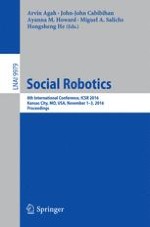2016 | OriginalPaper | Chapter
Investigating the Effects of the Persuasive Source’s Social Agency Level and the Student’s Profile to Overcome the Cognitive Dissonance
Authors : Khaoula Youssef, Jaap Ham, Michio Okada
Published in: Social Robotics
Publisher: Springer International Publishing
Activate our intelligent search to find suitable subject content or patents.
Select sections of text to find matching patents with Artificial Intelligence. powered by
Select sections of text to find additional relevant content using AI-assisted search. powered by
